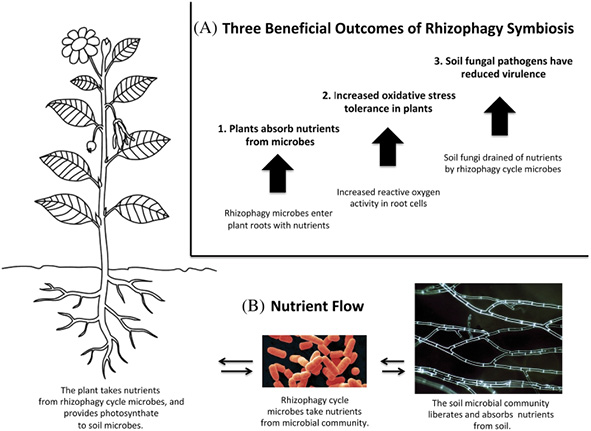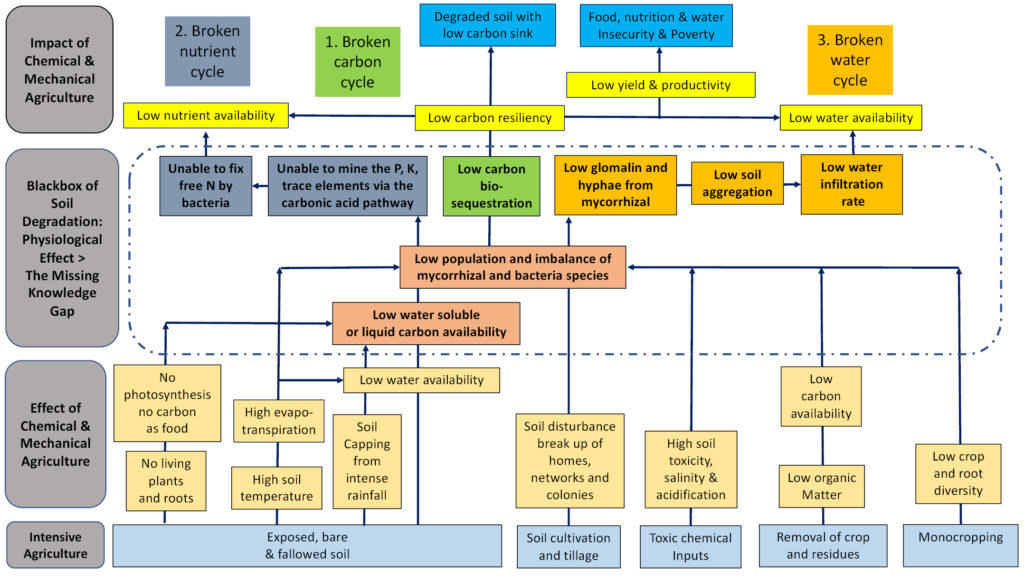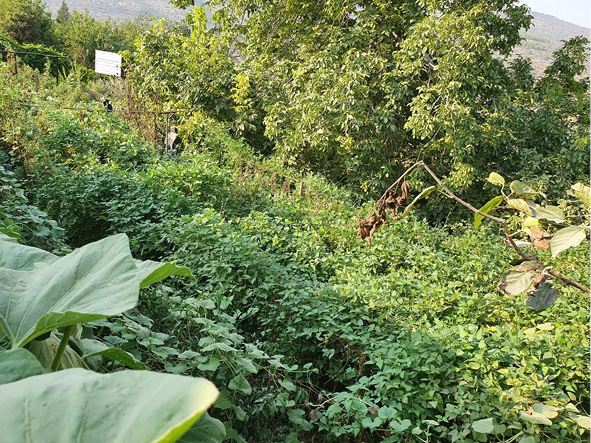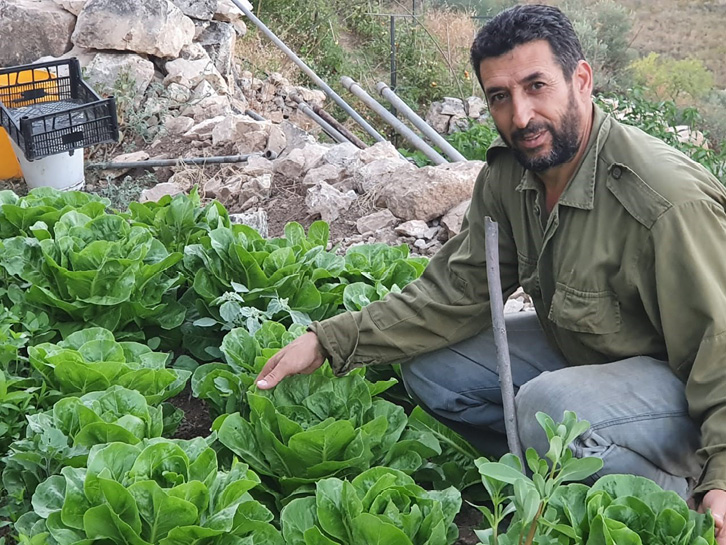
Leguminous plants (e.g., chickpeas, fava beans, fenugreek, clover, vetches) have been known to form important relationships with bacteria to capture nitrogen from the air and make it available for healthy plant growth. New studies are beginning to reveal some of the fascinating secrets of the mutual and symbiotic association between soil microorganisms, such as bacteria and mycorrhizae fungi, and many ordinary crop plants. For example, plants are able to attract beneficial bacteria to enter their root tips by enticing them with “liquid carbon” as food. Once inside the root, the bacteria will exchange their soluble nutrients for the carbon from the host plant. When the bacteria run out of nutrients, they will travel up the root and stimulate new root hair to grow. This will allow the bacteria to be “expelled” from the root hairs and return back to the soil to gather more nutrients in the soil. Dr. James White of Rutgers University (USA), referred to this process as the “rhizophagy cycle.” (See Figure 1: Benefits of the Rhizophagy Symbiosis.)

Studies have also revealed the important role that mycorrhizae fungi can play in promoting the health of crop plants and their soil. It is well known that mycorrhizae fungi can attach themselves to the root of a plant and help it absorb more phosphate from the soil. But more recent findings have shown that mycorrhizae fungi can form a gluey protein called glomalin to protect their thin filaments (hyphae) from decay and attacks by soil microbes. When these thin filaments age, often found in older roots, the filaments will break down and shed these gluey glomalin proteins to strengthen soil structures by binding together the silt, clay, and sand to form soil clumps or soil aggregates. Soil aggregates become their “homes” to absorb and store more water, carbon, and nutrients. This will protect the soil and nutrients from easily being washed and leached away during heavy rain. The carbon dioxide captured and stored within the soil aggregates, organic matters, microbes, root systems, and above-ground biomass through bio-sequestration can enable healthy soil and plants to draw down carbon from the atmosphere and serve as a carbon sink.
Upon this handful of soil our survival depends. Husband it, and it will grow our food, our fuel, and our shelter, and surround us with beauty. Abuse it, and the soil will collapse and die, taking humanity with it.
Atharva Veda, Sanskrit scripture, c. 1200 BC
Farming and gardening practices that are harmful to these bacteria and mycorrhizae populations can break up the relationship between the plants and these bacteria, preventing the exchange of carbon, nutrients, and water. Adding too much chemical fertilizer and continuously disturbing the soil through ploughing or cultivation can have a profound effect on these vulnerable bacteria and mycorrhizae communities. Likewise, leaving the soil surface bare and exposed to high temperatures and heavy rain can alter the growth and health of these microorganisms. (See photo 2.) The loss of bacteria and mycorrhizae can also affect other microorganisms in the soil that feed on them, and eventually destroy the entire soil food web, leading to the loss of biodiversity, including earthworms, insects, birds, small mammals, and apex predators such as owls or eagles. In some areas, 70 years of industrial farming have turned healthy soil into “dirt,” a sterile medium where very little can grow without the expensive inputs of fertilizers and other chemicals. (See Figure 2.)

Waking up to the unintended consequences of intensive farming, some farmers around the world, including some in Palestine, look for alternative farming practices to break away from the perpetual cycle of chemical dependency and increasing indebtedness, to the point of bankruptcy in some cases.*1 Based on the findings explained above, one can see that farming and gardening practices that can protect and enhance the growth, health, and diversity of these bacteria, mycorrhizae, and earthworms in the soil can enable the carbon, nutrient, and water cycles to function efficiently, providing high soil fertility and resiliency and improving yield and productivity. (See photo 2.) The bacteria and mycorrhizae can grow better if they are provided with sufficient liquid carbon as food from the roots of crop plants and carbon that is made available from high water-soluble organic matter in the soil (e.g., from compost, cover crops, or livestock manure). In addition, the beneficial bacteria can make the crop plants more able to tolerate heat or drought stress conditions as well as pest and diseases.

The nation that destroys its soil destroys itself. Franklin Roosevelt, 1937
Perhaps a similar resilient and regenerative system could explain how early agriculture that started in this region around 10,000 years ago had helped to make the Fertile Crescent area the cradle of civilization. This might also explain why the women farmers who practice the traditional ba’li (rain-fed) system in the Deir Ballut area, Salfit District in the West Bank, have been resilient for the past 70 years without the use of chemical inputs or irrigation, as reported in 2018 by Dr. Omar Tesdell of Birzeit University.*2 Due to many restrictions, these women were not able to use chemicals or dig wells for irrigation systems and were forced to rely on the traditional ba’li rain-fed system. The GIS data on land use from 1947 to 2017 show that due to the tight restrictions, many farmers had to abandon their farms while these women farmers are still able to produce healthy and safe food based on a diverse range of up to 21 baladi (local landraces) heirloom seeds. It was also found that bacteria have the capacity to travel up the plant from the root to enter into the seeds. These bacteria will enter the soil when the seeds germinate, begin to harness the nutrients from the soil, and make the nutrients available to the growing seedlings when they re-enter the roots of the seedlings. Now we know why saving and growing with baladi heirloom seeds can be beneficial in promoting strong root and shoot growth whereas modern seeds tend to have lost some of this capacity, and adding chemical seed treatment could harm the bacteria.
There are emerging studies that indicate a symbiotic relationship between the soil’s microorganisms and crop plants. Intensive farming practices that rely heavily on chemicals and tillage can break this delicate relationship, disturb the soil, and possibly lead to soil erosion and desertification.
Palestine is especially well-positioned to adopt and scale up these regenerative agricultural practices as there are already local farmers and pioneers such as Saad Dagher and his colleagues (e.g., Raya Ziada, Lina Ismail, Yasmin Younis, and Mohammad Khweirah, and others) who have been promoting agroecology farming to produce safe and healthy food for local markets based on the principles of no tillage, no chemical inputs, diverse cropping mainly under the ba’li rain-fed system. (See photo 3.) “There is still very little awareness about these safe and alternative farming practices and fear of transition remains a challenge,” explained Saad Dagher. There are also professors such as Dr. Heba Al Fares and Dr. Tawfiq Qubbaj at Najah University who teach students how to grow safe and healthy food using ecologically and environmentally sound practices. Mohamed Ruzzi is promoting regenerative agriculture with no tilling and no chemical inputs among the 1,200 farmers associated with the Palestinian Fair Trade Association in the West Bank who supply certified fair trade olives and dried herbs for export to Europe and the United States under the association’s program titled Regenerative Farming in Palestine for Social and Ecological Resilience.*3

In light of these research studies and based on on-the-ground experience in Palestine, the United Nations World Food Programme (WFP) is keen to support vulnerable smallholder farmers (under five dunums), home gardeners, and communities to scale up and replicate these regenerative farming practices that can harness the power of nature to produce safe and nutritious food while protecting the environment and climate. WFP, in partnership with the Environment Quality Authority (EQA), the Food and Agriculture Organization, and other potential partners, intends to access international climate finance (e.g., Green Climate Fund) to enhance the resilience, livelihoods, and food production of vulnerable farmers and communities in the West Bank and Gaza Strip. The project seeks to tackle the root causes of climate vulnerability and soil degradation by overcoming the barriers (institutional, technical, financial, business, market, and social and cultural) for the scaling up of climate-resilient regenerative agriculture.
There is growing interest – worldwide and in Palestine – in alternative farming practices that respect nature’s way of working while still producing enough healthy food for people. Building on the existing local practices, WFP Palestine and its partners intend to scale up the regenerative agricultural practices that harness the power of nature to produce safe and nutritious food while protecting the environment and drawing down carbon from the atmosphere.
Farmers and all WFP partners will be trained in the principles and science of developing healthy, productive, regenerative agriculture ecosystems. Equipped with the latest science-based knowledge, farmers and value-chain actors will be able to make informed decisions on how to best farm their land in a regenerative way. This will not only help to produce safe and nutrient-dense food, but farmers will be incentivized to take care of and protect their precious productive assets (including rejuvenated soil, land, and water) and the ecosystem, resulting in improved degraded land; improved water infiltration rate to reduce soil erosion, leaching, and runoffs; and reduced chemical pollution of water sources and aquifers. Furthermore, our proud Palestinian farmers will be playing a small but concrete part in helping to tackle global warming by drawing down carbon from the atmosphere through their regenerated soil and ecosystem as encouraged by the movie titled Kiss the Ground. As Mr. Nedal Katbeh-Bader of EQA has said, “This is a timely opportunity to build back better, greener, and smarter as a post-COVID-19 recovery strategy.”

*1 Gabe Brown, Dirt to Soil: One Family’s Journey to Regenerative Agriculture, Vermont: Chelsea Green Publishing, 2018; see also keynote speech at Farming for the Future, Van Buren Conservation District, March 10, 2020, video available at https://www.youtube.com/watch?v=ExXwGkJ1oGI&ab_channel=VanBurenCD; and Isabelle Tree, Wilding: The Return of Nature to a British Farm, Pan MacMillan, 2018. A video with a community talk at Brighton Natural Health Center is available at https://www.youtube.com/watch?v=kvD1DGSS8Aw&ab_channel=BrightonNaturalHealthCentre.
*2 Omar Tesdell, Yusra Othman, and Saher Alkhoury, “Rainfed agroecosystem resilience in the Palestinian West Bank, 1918–2017,” Agroecology and Sustainable Food Systems, 43(1):21-39, 2019.
*3 For more information, please visit https://www.resilience.org/stories/2020-02-20/regenerative-farming-in-palestine-for-social-and-ecological-resilience/.
*4 Dr. James White et al., 2018, “Rhizophagy Cycle: An Oxidative Process in Plants for Nutrient Extraction from Symbioti Microbes,” Microorganisms 6 (3).


